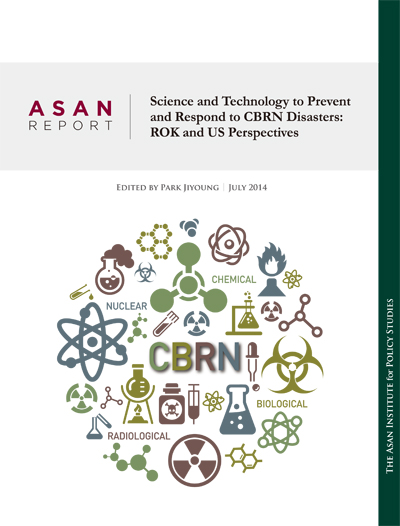영상
출간물
아산리포트
출간물 | 아산리포트
Science and Technology to Prevent and Respond to CBRN Disasters: ROK and US Perspectives
박지영
1,6752014.08.01
Executive Summary
The advancement of science and technology brings
us prosperous futures and gives comfort to our lives. The tools and knowledge
generated by science and technology have transformed the way we approach
health, agriculture, energy, development, communications, education, social
interactions, and security. Many of these advances and uses offer great benefit
to modern society, but some have increased risks to health, security, and
sovereignty.Sometimes it brings adverse effects on human life with respect to security
on account of being misused accidently or intentionally. The major areas of
concern regarding adverse effects are chemical, biological, radiological, and
nuclear (CBRN) because they may induce mass casualties and have the potential
for damaging long-term effects. The science and technology community should
therefore make every effort to contribute to the prevention of CBRN types of
disasters.
The scientific community is an important partner
in preventing and responding to, as well as remediating disasters involving
these agents. Science can create research environments that minimize misuse and
negligence. It can also provide information about given situations that help
policymakers, which is a very important interface between the science community
and the policymaking community to make informed or policy-relevant decisions
that are based on the appropriate and most relevant information.
The United States national security community is
unique in its interactions with its science and technology community. The US
government has established several programs during the past two decades to
reach out to scientists to access expertise, raise awareness of security risks
associated with emerging technologies and research or diagnostic facilities,
and build trust and partnership with key federal agencies. Examples of these
efforts include the National Science Advisory Board for Biosecurity and the outreach
activities of the Weapons of Mass Destruction Directorate (WMDD) of the Federal
Bureau of Investigation (FBI). Both of these efforts have sought to engage the
scientific community in preventing potential national security risks from
within their scientific environments.
The Korean government provides 81 types of safety
information and 14 agencies at different levels are operating 26 websites. To
promote science and technology regarding disaster and safety management, the
Minister of Security and Public Administration must put together the disaster
and safety management technology development plans of related central
administrative agencies every 5 years, have them reviewed by the coordinating
committee and the national science and technology council, establish comprehensive
disaster and safety management technology development plans, and prepare and enforce policies for promoting
science and technology in disaster and safety management. Korea is ranked No. 7
in the world in terms of R&D investments, but the disaster and safety
sector accounts for only 1.26 percent of the government’s R&D budget. As disasters do not
occur continuously or regularly, and happen randomly at any time in various
sizes and shapes, it is impossible to accurately predict the effects of
investments in their prevention or responses thereto, but the effects of safety
inspection technologies, fine detection technologies, and technologies for
recovering from polluted soil, air, and water cannot be anticipated without
related technologies and R&D. Science, technology, and R&D are playing
a pivotal role in maintaining the sound development of Korea,
which transformed itself from an agricultural country into an industrial
country in half a century.
The case of the Fukushima disaster is introduced
as an example of an S&T role in responding to CBRN accidents. The S&T
community can support the community by providing its expertise towards the
overall response to a wide-area incident. The supporting actions start with
customer identification and their needs, development of target products, and
delivery of the developed products to the customers. The S&T community
needs to develop strong lines of communication within the S&T community itself
regarding effective customer support and outreach activities. In addition, the
S&T community should continue to promote its scientific integrity for
individual scientists and engineers. This integrity promotion effort will
ensure the transparent support to customers with the highest quality scientific
and ethical standards.
This report is the outcome of the workshop held by
the Asan Institute for Policy Studies of the Republic of Korea and the American
Association for the Advancement of Science Center for Science, Technology, and
Security Policy on Science and Technology to
Prevent and Respond to CBRN Disasters: US and South Korean Perspectives. Through this report, the diverse roles and solutions that
science and technology can provide to prevent and mitigate disasters involving
chemical, biological, radiological, and nuclear materials is introduced. The
outcome of this work will be increased awareness of the integral role that the
science and technology community plays in addressing local, national, and
transnational CBRN incidents; the importance of building on the
multi-disciplinary expertise of the scientific community; and the strength of integrating
the social and natural sciences together to enhance efforts and policy
discussions related to prevention and response to natural or man-made disasters
involving CBRN materials.

박지영
Senior Research Fellow
박지영 박사는 아산정책연구원의 과학기술정책센터 선임연구위원이다. 서울대학교에서 핵공학 학사와 석사, 미국 University of Michigan에서 핵공학 박사학위를 취득하였으며 서울대학교 정책학 석사학위도 취득하였다, 2000년부터 2012년까지 한국과학기술기획평가원에 재직하였으며 R&D 타당성조사 센터장을 역임하였다. 주요연구분야는 핵정책, 근거중심 과학기술정책, 과학기술과 안보정책 등이다.




